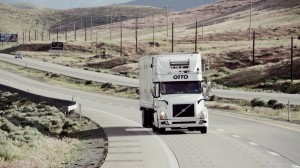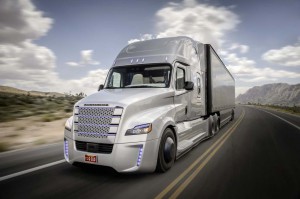Until recently, much of the focus on autonomous vehicles zeroed in on Google’s efforts with its little marshmallow-shaped car and some of the plans by automakers like Tesla, Cadillac, Audi and others, and now add Otto to the list.
Otto is the brainchild of three former Google engineers who felt that while an autonomous car was fine, self-driving heavy duty trucks could be really revolutionary.
The three former Googlers, Anthony Levandowski, Lior Ron and Don Burnette, have been joined by another robotics expert, Claire Delaunay, to launch Otto, which aims to make America’s hundreds of thousands of miles of highways safer by perfecting autonomous trucks.
“Our goal is to make trucks drive as humanly as possible, but with the reliability of machines,” Levandowski told the Detroit Free Press.
The trucks, which are still in their infancy, would leave the city driving to human drivers; however, once on the open road, it would be all robot, all the time. Levandowski might just be the right man to lead this project.
(Driverless truck aims to keep workers, motorists safe in construction zones. For more, Click Here.)
In addition to working on Google’s self-driving car, he also designed the PriBot, a self-driving Prius, that delivered a pizza by crossing the San Francisco-Oakland Bay Bridge in 2008. He also developed an autonomous motorcycle as well.
Despite the extensive expertise of Otto’s leaders, as well as its 40 other employees and the extensive progress made with autonomous cars, it may take some time before the dream of a self-driving semi is a reality.
Steven Shladover, program manager for mobility at the University of California’s Partners for Advanced Transportation Technology claims the technology for a self-driving heavy duty truck is still a long way from being reliable enough to convince government regulators that a robot can be entrusted to steer a truck traveling at highway speeds without causing a catastrophic accident.
“I don’t want to be on that highway when there is nobody there to take over a truck with 80,000 pounds of cargo and I don’t think I know anyone else who would want to be,” Shladover said to the Free Press. “The consequences of any kind of failure in any component would be too severe.”
(Click Here to see more about the first autonomous truck: Freightliner’s Inspiration.)
Undaunted, the four-month-old startup is ready to begin testing on three trucks. In fact, it recently completed its first test in Nevada, which is currently one of the few states allowing the testing of the large autonomous trucks.
Otto is not the only company looking to develop a driverless truck. In fact, it’s not even the first to have one rolling down U.S. roads. Royal Truck & Equipment, a specialty vehicle manufacturer near Bethlehem, Pennsylvania, developed trucks fitted with special devices, called attenuators, designed to protect workers as well as motorists trying to navigate through temporary work zones.
Attenuators are designed to provide a rolling crash barrier, but while that can save construction workers, as well as motorists, they put at risk the people that drive the trucks. So, Royal Truck has developed a system that can be operated autonomously.
Daimler AG’s Freightliner subsidiary demonstrated its first semi-autonomous 18-wheeler, a prototype 70,000-pound truck that, called the Inspiration last year. Capable of driving hands-free on well-marked roads, the German company has been testing its truck on Nevada roads as well.
(To see more about automakers poaching key talent as competition heats up, Click Here.)
Daimler officials stressed that they have already logged more than 10,000 miles testing the Inspiration truck, enough to make them feel confident it can operate safely on public roads. That said, they noted it is what the industry refers to as Level 3 technology. In lay terms, that means the rig cannot operate under all conditions without driver input.


